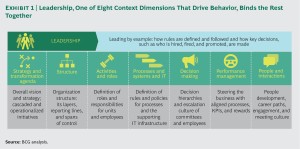Businesses compete in a world that is growing ever more complex. Disruptive technologies emerge with increasing frequency. Customers’ needs and demands change at breakneck speed. New competitors are always entering the fray.
In their attempts to reduce uncertainty and reestablish control amid this new complexity, companies tend to introduce new reports, new rules, and new processes. Such reactions, however, simply translate external complexity into internal “complicatedness”—the counterproductive proliferation of cumbersome structures, processes, and systems. Complicatedness hinders productivity by creating a work environment that leaves employees disengaged and unmotivated. To be successful in today’s complex and fast-changing world, companies must be highly agile and flexible—able to identify opportunities and make informed decisions quickly in order to exploit those opportunities. Those companies that are able to hone that agility in the face of increasing external complexity will emerge with a clear competitive advantage.
Few companies, however, possess these capabilities. In our discussions with business leaders, we frequently hear about companies that wrestle with a host of internal challenges, including slow decision-making processes, endless meetings, disengaged employees, and increasing costs. And it’s not only senior management that recognizes company shortcomings: employees deep in the organization tell us about their frustrations with meetings that are overcrowded with attendees who have no clearly relevant role, too many initiatives going on in parallel, little recognition from supervisors for results achieved, lack of clarity regarding decision rights, and an inability to get things done quickly.
But while management and other employees are obviously well aware of their company’s flaws, too often they are unable to remedy them. They either refrain from trying to tackle the big problems, or they attempt to address them, only to have the effort fail or even be counterproductive. Many such disappointments stem from actions that, on the surface at least, are reasonable. Management instinctively takes aim at the problems with targeted, direct, and seemingly decisive measures, creating new structures, rules, reports, KPIs, and committees. In many cases, such measures ignore the underlying root causes and ultimately impose even more complicatedness.
Working with numerous clients, each of which started with varying degrees of complicatedness, we have learned that all companies can effectively fight complicatedness and can successfully simplify in a smart way. The key is to understand the link between performance problems and employee behaviors and then determine which elements of the complex, intertwined organization dynamics drive these behaviors. We follow four steps—starting with the identification of the key performance problems and culminating in the design and implementation of solutions. And while this approach demands commitment and energy—as well as a new perspective on what drives company performance—the payoff far exceeds the effort and resources expended.
The Challenge of Complicatedness
Challenges related to complicatedness are deeply entrenched in many large organizations across all regions and industries. But if so many people at all levels are aware of these issues, why are companies unable to fix them?
On the basis of our observation of organizations in numerous industries around the world, we believe that failure is typically the result of one, or several, of a number of (perceived or real) causes:
- The problems and the underlying root causes are difficult to identify and, for the most part, unique to each company. There is almost never a single silver-bullet solution, and implementing standard best practices does not solve the problems.
- The problems appear too big or too “slippery” to tackle. Common refrains: “We would need an entirely different culture to do that” and “Once the external environment changes, things will work out again.”
- The problems are hard to measure, and, therefore, it’s difficult to make the business case to tackle them. The cost of time wasted in unproductive meetings, for example, is much harder to quantify than the cost of physical waste piling up next to a machine.
- Responsibilities for a given problem are divided among various parties and silos, and no one feels compelled to take ownership of the problem. This is particularly emphasized if the problem has in the past proved hard to resolve.
When internal complicatedness is not addressed, tangible value is destroyed. This can be reflected in increasing costs, slow and poor decision making, low employee engagement, dissatisfied customers, and declining business results.
The Power of Simplicity
To successfully address complicatedness, companies need to start by recognizing the principles that form the foundation of BCG’s approach to simplification, or Smart Simplicity.1 There are two key principles:
- Performance is a result of what people do (behaviors). A company’s performance is ultimately driven by employee and customer behaviors. These include the behaviors of leaders (for example, how they lead, whom they promote or make company heroes, what they measure, and what they talk about in meetings) and employees (for example, how they interact, what they do and do not do, and how readily they share information).
- Behaviors of people are driven by rational reactions to their context. People do what they do because it is the logical solution given the context in which they work. Therefore, if a company wants to improve performance, it has to make the desired behaviors rational. Behaviors are observable: they are what people actually do, day in and day out. Behaviors—not a discussion of what people are not (but maybe should be) doing—should be the focus. If it is possible to articulate what motivates people, what they aim for, the means they have to achieve their goals, and what is in their way, it is also possible to understand what causes their behaviors. Behaviors can, therefore, be influenced by smart adjustments to the company environment—the “context”—to make the desired choices the logical ones.
…
Authors: Jaap Backx,Partner & Managing Director, Amsterdam; Christoph Hilberath, Principal, Munich; Reinhard Messenböck, Senior Partner & Managing Director, Melbourne; Yves Morieux, Senior Partner & Managing Director, Washington, DC; Henning Streubel, Senior Partner & Managing Director, San Francisco
More: BCG
